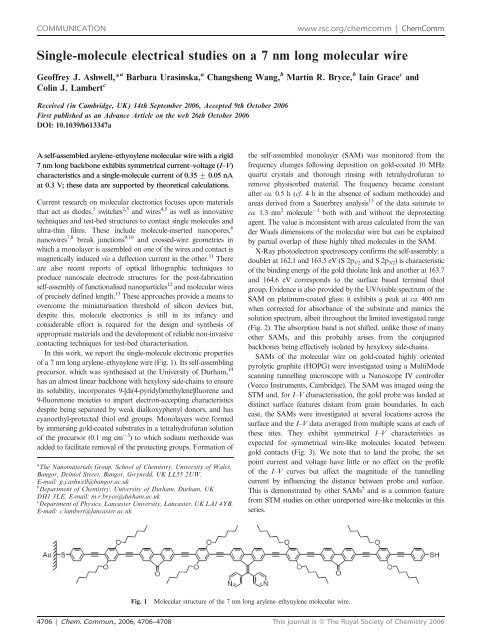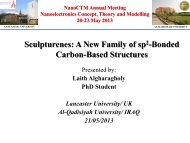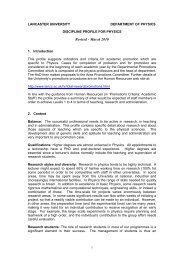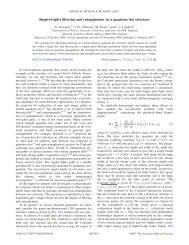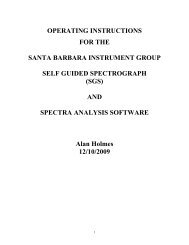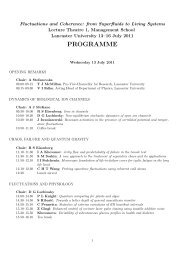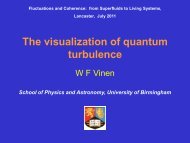Single-molecule electrical studies on a 7 nm long molecular wire
Single-molecule electrical studies on a 7 nm long molecular wire
Single-molecule electrical studies on a 7 nm long molecular wire
You also want an ePaper? Increase the reach of your titles
YUMPU automatically turns print PDFs into web optimized ePapers that Google loves.
COMMUNICATION<br />
www.rsc.org/chemcomm | ChemComm<br />
<str<strong>on</strong>g>Single</str<strong>on</strong>g>-<str<strong>on</strong>g>molecule</str<strong>on</strong>g> <str<strong>on</strong>g>electrical</str<strong>on</strong>g> <str<strong>on</strong>g>studies</str<strong>on</strong>g> <strong>on</strong> a 7 <strong>nm</strong> l<strong>on</strong>g <strong>molecular</strong> <strong>wire</strong><br />
Geoffrey J. Ashwell,* a Barbara Urasinska, a Changsheng Wang, b Martin R. Bryce, b Iain Grace c and<br />
Colin J. Lambert c<br />
Received (in Cambridge, UK) 14th September 2006, Accepted 9th October 2006<br />
First published as an Advance Article <strong>on</strong> the web 26th October 2006<br />
DOI: 10.1039/b613347a<br />
A self-assembled arylene–ethynylene <strong>molecular</strong> <strong>wire</strong> with a rigid<br />
7 <strong>nm</strong> l<strong>on</strong>g backb<strong>on</strong>e exhibits symmetrical current–voltage (I–V)<br />
characteristics and a single-<str<strong>on</strong>g>molecule</str<strong>on</strong>g> current of 0.35 ¡ 0.05 nA<br />
at 0.3 V; these data are supported by theoretical calculati<strong>on</strong>s.<br />
Current research <strong>on</strong> <strong>molecular</strong> electr<strong>on</strong>ics focuses up<strong>on</strong> materials<br />
that act as diodes, 1 switches 2,3 and <strong>wire</strong>s 4,5 as well as innovative<br />
techniques and test-bed structures to c<strong>on</strong>tact single <str<strong>on</strong>g>molecule</str<strong>on</strong>g>s and<br />
ultra-thin films. These include <str<strong>on</strong>g>molecule</str<strong>on</strong>g>-inserted nanopores, 6<br />
nano<strong>wire</strong>s 7,8 break juncti<strong>on</strong>s 9,10 and crossed-<strong>wire</strong> geometries in<br />
which a m<strong>on</strong>olayer is assembled <strong>on</strong> <strong>on</strong>e of the <strong>wire</strong>s and c<strong>on</strong>tact is<br />
magnetically induced via a deflecti<strong>on</strong> current in the other. 11 There<br />
are also recent reports of optical lithographic techniques to<br />
produce nanoscale electrode structures for the post-fabricati<strong>on</strong><br />
self-assembly of functi<strong>on</strong>alised nanoparticles 12 and <strong>molecular</strong> <strong>wire</strong>s<br />
of precisely defined length. 13 These approaches provide a means to<br />
overcome the miniaturisati<strong>on</strong> threshold of silic<strong>on</strong> devices but,<br />
despite this, <str<strong>on</strong>g>molecule</str<strong>on</strong>g> electr<strong>on</strong>ics is still in its infancy and<br />
c<strong>on</strong>siderable effort is required for the design and synthesis of<br />
appropriate materials and the development of reliable n<strong>on</strong>-invasive<br />
c<strong>on</strong>tacting techniques for test-bed characterisati<strong>on</strong>.<br />
In this work, we report the single-<str<strong>on</strong>g>molecule</str<strong>on</strong>g> electr<strong>on</strong>ic properties<br />
of a 7 <strong>nm</strong> l<strong>on</strong>g arylene–ethynylene <strong>wire</strong> (Fig. 1). Its self-assembling<br />
precursor, which was synthesised at the University of Durham, 14<br />
has an almost linear backb<strong>on</strong>e with hexyloxy side-chains to ensure<br />
its solubility, incorporates 9-[di(4-pyridyl)methylene]fluorene and<br />
9-fluoren<strong>on</strong>e moieties to impart electr<strong>on</strong>-accepting characteristics<br />
despite being separated by weak dialkoxyphenyl d<strong>on</strong>ors, and has<br />
cyanoethyl-protected thiol end groups. M<strong>on</strong>olayers were formed<br />
by immersing gold-coated substrates in a tetrahydrofuran soluti<strong>on</strong><br />
of the precursor (0.1 mg cm 23 ) to which sodium methoxide was<br />
added to facilitate removal of the protecting groups. Formati<strong>on</strong> of<br />
a The Nanomaterials Group, School of Chemistry, University of Wales,<br />
Bangor, Deiniol Street, Bangor, Gwynedd, UK LL55 2UW.<br />
E-mail: g.j.ashwell@bangor.ac.uk<br />
b Department of Chemistry, University of Durham, Durham, UK<br />
DH1 3LE. E-mail: m.r.bryce@durham.ac.uk<br />
c Department of Physics, Lancaster University, Lancaster, UK LA1 4YB.<br />
E-mail: c.lambert@lancaster.ac.uk<br />
the self-assembled m<strong>on</strong>olayer (SAM) was m<strong>on</strong>itored from the<br />
frequency changes following depositi<strong>on</strong> <strong>on</strong> gold-coated 10 MHz<br />
quartz crystals and thorough rinsing with tetrahydrofuran to<br />
remove physisorbed material. The frequency became c<strong>on</strong>stant<br />
after ca. 0.5 h (cf. 4 h in the absence of sodium methoxide) and<br />
areas derived from a Sauerbrey analysis 15 of the data saturate to<br />
ca. 1.3 <strong>nm</strong> 2 <str<strong>on</strong>g>molecule</str<strong>on</strong>g> 21 both with and without the deprotecting<br />
agent. The value is inc<strong>on</strong>sistent with areas calculated from the van<br />
der Waals dimensi<strong>on</strong>s of the <strong>molecular</strong> <strong>wire</strong> but can be explained<br />
by partial overlap of these highly tilted <str<strong>on</strong>g>molecule</str<strong>on</strong>g>s in the SAM.<br />
X-Ray photoelectr<strong>on</strong> spectroscopy c<strong>on</strong>firms the self-assembly: a<br />
doublet at 162.1 and 163.5 eV (S 2p 1/2 andS2p 3/2 ) is characteristic<br />
of the binding energy of the gold thiolate link and another at 163.7<br />
and 164.6 eV corresp<strong>on</strong>ds to the surface based terminal thiol<br />
group. Evidence is also provided by the UV/visible spectrum of the<br />
SAM <strong>on</strong> platinum-coated glass: it exhibits a peak at ca. 400 <strong>nm</strong><br />
when corrected for absorbance of the substrate and mimics the<br />
soluti<strong>on</strong> spectrum, albeit throughout the limited investigated range<br />
(Fig. 2). The absorpti<strong>on</strong> band is not shifted, unlike those of many<br />
other SAMs, and this probably arises from the c<strong>on</strong>jugated<br />
backb<strong>on</strong>es being effectively isolated by hexyloxy side-chains.<br />
SAMs of the <strong>molecular</strong> <strong>wire</strong> <strong>on</strong> gold-coated highly oriented<br />
pyrolytic graphite (HOPG) were investigated using a MultiMode<br />
scanning tunnelling microscope with a Nanoscope IV c<strong>on</strong>troller<br />
(Veeco Instruments, Cambridge). The SAM was imaged using the<br />
STM and, for I–V characterisati<strong>on</strong>, the gold probe was landed at<br />
distinct surface features distant from grain boundaries. In each<br />
case, the SAMs were investigated at several locati<strong>on</strong>s across the<br />
surface and the I–V data averaged from multiple scans at each of<br />
these sites. They exhibit symmetrical I–V characteristics as<br />
expected for symmetrical <strong>wire</strong>-like <str<strong>on</strong>g>molecule</str<strong>on</strong>g>s located between<br />
gold c<strong>on</strong>tacts (Fig. 3). We note that to land the probe, the set<br />
point current and voltage have little or no effect <strong>on</strong> the profile<br />
of the I–V curves but affect the magnitude of the tunnelling<br />
current by influencing the distance between probe and surface.<br />
This is dem<strong>on</strong>strated by other SAMs 5 and is a comm<strong>on</strong> feature<br />
from STM <str<strong>on</strong>g>studies</str<strong>on</strong>g> <strong>on</strong> other unreported <strong>wire</strong>-like <str<strong>on</strong>g>molecule</str<strong>on</strong>g>s in this<br />
series.<br />
Fig. 1<br />
Molecular structure of the 7 <strong>nm</strong> l<strong>on</strong>g arylene–ethynylene <strong>molecular</strong> <strong>wire</strong>.<br />
4706 | Chem. Commun., 2006, 4706–4708 This journal is ß The Royal Society of Chemistry 2006
Fig. 2 UV/visible spectrum of the self-assembled <strong>molecular</strong> <strong>wire</strong> and an<br />
outline (broken line) of the soluti<strong>on</strong> spectrum where l max 5 400 <strong>nm</strong> in<br />
chloroform.<br />
Fig. 4 CurrentjumpwiththegoldSTMprobelocatedatafixedheight<br />
above the SAM with a sample bias of 0.3 V. The increased current, which<br />
is attributed to adsorpti<strong>on</strong> of the terminal thiol group to the gold probe,<br />
persists for ca. 260 ms in this case and is the l<strong>on</strong>gest recorded event.<br />
Fig. 3 I–V characteristics of the <strong>molecular</strong> <strong>wire</strong> deposited as a SAM <strong>on</strong><br />
gold-coated HOPG and c<strong>on</strong>tacted by a gold probe with a set-point current<br />
of 0.3 nA and sample bias of 30 mV. The designated polarity relates to the<br />
substrate electrode.<br />
Using the method of Haiss et al., 16 single-<str<strong>on</strong>g>molecule</str<strong>on</strong>g> STM <str<strong>on</strong>g>studies</str<strong>on</strong>g><br />
were performed by m<strong>on</strong>itoring the current as a functi<strong>on</strong> of time at<br />
locati<strong>on</strong>s across the SAM with the gold probe located at a fixed<br />
height and within c<strong>on</strong>tacting distance of the surface to chemisorb<br />
the thiol-terminated <strong>wire</strong>s. The <str<strong>on</strong>g>molecule</str<strong>on</strong>g>s sp<strong>on</strong>taneously adsorb<br />
and desorb with abrupt changes in the tunnelling current (Fig. 4).<br />
Each adsorpti<strong>on</strong>/desorpti<strong>on</strong> event persists for ca. 10 to 300 ms with<br />
almost 50% of all current jumps within the range 0.35 ¡ 0.05 nA<br />
for a surface bias of 0.3 V. It is attributed to the single-<str<strong>on</strong>g>molecule</str<strong>on</strong>g><br />
current and therefore, adsorpti<strong>on</strong> via a single thiolate link to the<br />
gold probe. Significantly, thirteen of the ninety-nine recorded<br />
events exhibit current jumps of 0.65 ¡ 0.05 nA which is almost<br />
double the aforementi<strong>on</strong>ed value and probably corresp<strong>on</strong>ds to the<br />
probe c<strong>on</strong>tacting two <str<strong>on</strong>g>molecule</str<strong>on</strong>g>s. There is also tentative evidence of<br />
higher multiples with two events centred about 1.05 nA and<br />
another centred about 1.45 nA (Fig. 5), these being indicative of<br />
three and four-<str<strong>on</strong>g>molecule</str<strong>on</strong>g> c<strong>on</strong>tacts. However, these events corresp<strong>on</strong>d<br />
to <strong>on</strong>ly 3% of the total and we note that the histogram<br />
reveals a single high-current event that does not approximate to an<br />
integer multiple of the single-<str<strong>on</strong>g>molecule</str<strong>on</strong>g> value.<br />
Fig. 5 Histogram of 99 recorded current jumps at a sample bias of 0.3 V.<br />
About 50% (46 events) fall within the range 0.35 ¡ 0.05 nA with current<br />
jumps centred about 0.65 nA (13 events), 1.05 nA (2 events) and 1.45 nA<br />
(1 event) approximating to multiples thereof.<br />
The single-<str<strong>on</strong>g>molecule</str<strong>on</strong>g> current of ca. 0.35 nA at 0.3 V is about six<br />
times larger than the value displayed by the I–V plot at this voltage<br />
(Fig. 3). It can be explained by the latter being dependent up<strong>on</strong> the<br />
set point c<strong>on</strong>diti<strong>on</strong>s which influence the distance between probe<br />
and surface whereas the former is independent of the set point<br />
current 16 as the <str<strong>on</strong>g>molecule</str<strong>on</strong>g> is chemisorbed by both electrodes.<br />
Besides, we note that the upper limiting current exhibited by I–V<br />
curves of thiol-terminated <str<strong>on</strong>g>molecule</str<strong>on</strong>g>s approaches the corresp<strong>on</strong>ding<br />
single-<str<strong>on</strong>g>molecule</str<strong>on</strong>g> value obtained from the current jump method as<br />
the set point c<strong>on</strong>diti<strong>on</strong>s are altered to minimise the gap between<br />
surface and probe.<br />
In further <str<strong>on</strong>g>studies</str<strong>on</strong>g>, the electr<strong>on</strong>-accepting 9-[di(4-pyridyl)methylene]fluorene<br />
unit has been chemically modified by prot<strong>on</strong>ati<strong>on</strong> of<br />
both pyridyl units to provide a rectifying juncti<strong>on</strong> when combined<br />
with an adjacent electr<strong>on</strong>-d<strong>on</strong>ating layer of copper phthalocyanine-3,49,40,490-tetrasulf<strong>on</strong>ate.<br />
They exhibit rectificati<strong>on</strong> ratios of<br />
ca. 20 at ¡1 V and the directi<strong>on</strong> of electr<strong>on</strong> flow at forward bias is<br />
from the cathode to the electr<strong>on</strong>-accepting layer and from the<br />
electr<strong>on</strong>-d<strong>on</strong>ating layer to the anode.<br />
This journal is ß The Royal Society of Chemistry 2006 Chem. Commun., 2006, 4706–4708 | 4707
Fig. 6<br />
gold.<br />
Theoretical I–V behaviour of the <strong>molecular</strong> <strong>wire</strong> c<strong>on</strong>tacted by<br />
For the computed electr<strong>on</strong> transmissi<strong>on</strong> coefficient T(E) shown<br />
in Fig. 7 and a Fermi energy indicated by the dotted line, we<br />
obtain the following I–V characteristic, which agrees with the<br />
shape of the experimental curve of Fig. 3 and, to within a factor of<br />
order unity, agrees with the magnitude of the experimental current<br />
(jump) at 0.3 V as shown in Fig. 4.<br />
Forthis<strong>wire</strong>,T(E) exhibits Fano res<strong>on</strong>ances above the Fermi<br />
energy, associated with localised states <strong>on</strong> the substituent groups<br />
attached to the fluorene moieties (i.e. the keto oxygen and<br />
dipyridylmethylene). The positi<strong>on</strong> of these res<strong>on</strong>ances is sensitive<br />
to small perturbati<strong>on</strong>s <strong>on</strong> the side group, which could be induced<br />
chemically, geometrically or by gating. This opens up the exciting<br />
possibility of using these <strong>molecular</strong> <strong>wire</strong>s as single-<str<strong>on</strong>g>molecule</str<strong>on</strong>g><br />
sensors.<br />
We acknowledge the Department of Trade and Industry,<br />
QinetiQ, EPSRC, the MCRTN ‘RTNNANO’ and the Royal<br />
Society/Wolfs<strong>on</strong> Foundati<strong>on</strong> for support.<br />
Fig. 7 Zero bias transmissi<strong>on</strong> T(E) versus energy E through the 7 <strong>nm</strong><br />
<strong>molecular</strong> <strong>wire</strong>.<br />
We now compare the experimental results with a detailed ab<br />
initio simulati<strong>on</strong> of electr<strong>on</strong> transport through the n<strong>on</strong>-prot<strong>on</strong>ated<br />
self-assembled <str<strong>on</strong>g>molecule</str<strong>on</strong>g> and show that transport is dominated by<br />
the presence of Fano res<strong>on</strong>ances near the Fermi energy. To<br />
compute the c<strong>on</strong>ductance, we use a combinati<strong>on</strong> of the DFT code<br />
SIESTA 17 and a Green’s functi<strong>on</strong> scattering approach, as<br />
encapsulated in the n<strong>on</strong>-equilibrium <strong>molecular</strong> electr<strong>on</strong>ics<br />
SMEAGOL 18 code. Starting from the relaxed geometry, obtained<br />
from SIESTA, the isolated <str<strong>on</strong>g>molecule</str<strong>on</strong>g> is extended to include the<br />
surface layers of gold leads. A mean-field, DFT, tight binding<br />
Hamilt<strong>on</strong>ian of the <str<strong>on</strong>g>molecule</str<strong>on</strong>g> is obtained, from which a scattering<br />
matrix and electr<strong>on</strong> transmissi<strong>on</strong> coefficient T(E) are computed.<br />
For applied voltages up to approximately 2 V, the voltage<br />
dependence of T(E) is found to be insignificant and therefore, the<br />
I–V characteristic of Fig. 6 can be found by using formula (1)<br />
where m L/R 5 E F ¡ eV/2.<br />
I~ 2e ð mR<br />
T(E)dE (1)<br />
h m L<br />
Notes and references<br />
1 G. J. Ashwell, B. Urasinska and W. D. Tyrrell, Phys. Chem. Chem.<br />
Phys., 2006, 8, 3314.<br />
2 E.H.vanDijk,D.J.T.Myles,M.H.vanderVeenandJ.C.Hummelen,<br />
Org. Lett., 2006, 8, 2333.<br />
3 A. R. Pease, J. O. Jeppesen, J. F. Stoddart, Y. Luo, C. P. Collier and<br />
J. R. Heath, Acc. Chem. Res., 2001, 34, 433.<br />
4 J.M.Tour,Acc. Chem. Res., 2000, 33, 791.<br />
5 G. J. Ashwell, W. D. Tyrrell, B. Urasinska, C. Wang and M. R. Bryce,<br />
Chem. Commun., 2006, 1640.<br />
6 M.A.Reed,J.Chen,A.M.Rawlett,D.W.PriceandJ.M.Tour,Appl.<br />
Phys. Lett., 2001, 78, 3735.<br />
7 C.E.Gardner,M.A.Ghanem,J.W.Wils<strong>on</strong>andD.C.Smith,Anal.<br />
Chem., 2006, 78, 951.<br />
8 L.T.Cai,H.Skulas<strong>on</strong>,J.G.Kushmerick,S.K.Pollack,J.Naciri,<br />
R. Shashidar, D. L. Allara, T. E. Mallouk and T. S. Mayer, J. Phys.<br />
Chem. B, 2004, 108, 2827.<br />
9J.Reichert,R.Ochs,D.Beckmann,H.B.Weber,M.Mayorand<br />
H. v. Löhneysen, Phys. Rev. Lett., 2002, 88, 176804.<br />
10 B. Xu and N. J. Tao, Science, 2003, 301, 1221.<br />
11 J. G. Kushmerick, J. Naciri, J. C. Yang and R. Shashidhar, Nano Lett.,<br />
2003, 3, 897.<br />
12 S. W. Howell, S. M. Dirk, K. Childs, H. Pang, M. Blain, R. J.<br />
Sim<strong>on</strong>s<strong>on</strong>, J. M. Tour and D. R. Wheeler, Nanotechnology, 2005,16,<br />
754.<br />
13 G. J. Ashwell, P. Wierzchowiec, C. J. Bartlett and P. D. Buckle, Chem.<br />
Commun., submitted for publicati<strong>on</strong>.<br />
14 C. Wang, A. S. Batsanov and M. R. Bryce, Faraday Discuss., 2006, 131,<br />
221.<br />
15 G. Sauerbrey, Z. Phys., 1959, 155, 206.<br />
16 W. Haiss, R. J. Nichols, H. van Zalinge, S. J. Higgins, D. Bethell and<br />
D. J. Schiffrin, Phys. Chem. Chem. Phys., 2004, 6, 4330.<br />
17 J. M. Soler, E. Artacho, J. D. Gale, A. Garcia, J. Junquera,<br />
P. Ordej<strong>on</strong> and D. Sanchez-Portal, J. Phys.: C<strong>on</strong>dens. Matter, 2002,<br />
14, 2745.<br />
18 A. R. Rocha, V. Garcia-Suarez, S. W. Bailey, C. J. Lambert, J. Ferrer<br />
and S. Sanvito, Phys. Rev. B, 2006, 73, 085414.<br />
4708 | Chem. Commun., 2006, 4706–4708 This journal is ß The Royal Society of Chemistry 2006


